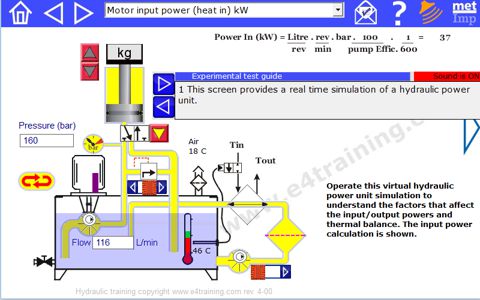Self-study lesson plans and training record download page.
Tips for operating and maintaining power units
The fluid reservoir is a good place to monitor the systems performance and fluid condition. Changing temperatures may indicate premature failures and fluid samples can be taken to check oil cleanliness and aging.
Before starting any system maintenance, always isolate the power to the power unit and fluid power lines leading away from it. Never isolate the return lines. If there is no return line check valve fitted or anti-syphon hole in the reservoir, then simply break the return line connection above the reservoir to vent the fluid and break the syphon.
Never leave any part of the reservoir open to atmosphere and always fill with new fluid, via a filter. Change air breathers regularly and make sure these have good filter ratings, not just strainers. Remember that tank pressures affect pump suction pressures and therefore pump life. Flow in and out of the reservoir must not affect suction pressures, even though they are directly connected.
Check fluid levels with cylinders extended and retracted. Remember that the original designer may not have known how many cylinders would be connected and the reservoirs can have a lot less volume when all cylinders are extended.
Check the equipment is suitable for the environment in which it is being used. Reservoir finishes are critical in all environments, particularly above the fluid level, but marine environments, for example, can lead to earlier failures due to the moist and salty atmosphere.
Typical power unit operating characteristics

There are no typical operating characteristics for power units as they are all so different.
Users should, however, be aware of the following parameters:
Flow rate against usable volume, with and without cylinders extended. Volumes around 3 to 5 times the pump flow should give stable operation. Volumes around 1 times the pump flow e.g. 10L with 10L/min pump can be achieved for occasional, intermitted use or with very great care and lots of development testing.
Fluid conditioning requirements. How much dirt does the system send back to the reservoir i.e. what is the filtration requirement to meet the valves or systems performance requirements? Also how severe could the system aeration be and is the reservoir designed well enough to deal with this?
Thermal balance i.e. how stable will the operating temperatures be. Power in against percentage of power going into heat, minus the heat loss from the reservoir and cooling.
Pump inlet pressures. What are the static and dynamic pressures that are seen at the pump suction port during hot and cold operation and is this within manufacturers advised limits?
How to specify hydraulic power units
If you are buying a standard 'off the shelf' power unit then potentially all you will need is the flow and pressure ratings. However, it is always far better to explain the full duty cycle and working environment to the supplier to ensure you achieve the desired life and duty of the equipment, as well as the basic performance.
Mounting pumps below reservoirs, for example, gives the best chance of extended pump life so is better than taking the risk with tank top mounted pumps.
Consider the cost of downtime. If the cost of downtime is high then it's worth adding extra features to better monitor the equipment's condition, maintain it more easily, duplicate components for redundancy in case of breakdown. These facilities may include:
Spare motor pump sets to provide power if one fails.
Pressure, return and offline filters to provide the best possible fluid cleanliness.
Sufficient isolator valves to permit easy maintenance and good access to all components.
Good condition monitoring with automatic electrical warning signals.
Good facilities to make flushing easier (see our flushing module).
Sight glass with isolation valves to allow the glass to be changed.
Design Tips, techniques, and potential issues
Pay careful attention to how the fluid flows around the reservoir. For example, taking care of the sizing and positioning of the return and suction pipes to ensure there are no dead spots within the reservoir. These effectively reduce the size of the reservoir with the consequential effect on its performance.
Protection and painting of reservoirs is always a difficult challenge. Stainless or low rust steels can offer significant advantages as they provide no risk of paint flecks contaminating the fluid.
Flat cover seals are particularly difficult to keep leak tight. This is complicated by the difficulty buying sheets of rubber with the sufficient material certification. It's generally preferable to use simple ridges etc to ensure seal compression all around any flat seals.